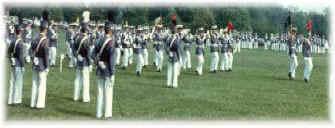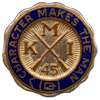 |
|
The founder of the Kentucky Military Institute, Robert T. P. Allen, was born in Baltimore, MD in 1813. He graduated 5th in his class at West Point, was a Captain in the Seminole War and during the Civil War was the commander of a Texas infantry regiment. He married Julia Bond, niece of President Andrew Jackson, whom he met while visiting the White House. In 1845, Allen purchased property south of Frankfort, KY, believing it would be a good location for a private military school. Established as the Kentucky Military Institute it had a reputation for excellent instructors, strict discipline and demanding academic courses. After the Civil War, the school changed its curriculum to prepare students for professional occupations. Allen was said to be a genius and worked on several inventions. Around the age of 60, he invented the KMI Steam Engine, the Allen typewriter and a steam wagon, precursor to the modern day automobile. During the early years, KMI went through bankruptcy, fires and even revolt of the cadets. In 1894, Col. Charles Fowler obtained the KMI charter after the school's original site was sold through bankruptcy, and transferred the charter to his school, the Kentucky Training School in Mt. Sterling. He continued operations as the Kentucky Military Institute after merging the two schools. Among the KTS students who were transferred to KMI, were seven young women. The "cadet-ettes" never wore the traditional blue-gray uniforms, but followed the same academic curriculum and disciplinary rules as the male cadets. In 1896 he purchased a historic plantation house in Lyndon, KY and opened for the new fall term. Col. Fowler believed that outdoor recreation in the Florida climate would be a great benefit to students in their scholastic work. He established winter quarters in Eau Gallie, now Melbourne, FL, in 1906. This began the annual trip to Florida for the winter session. After two fires, one in Lyndon, KY and the other at Eau Gallie, FL, KMI again went into bankruptcy. In the fall of 1924, Col. Charles B. Richmond and three other teachers formed a partnership and bought the KMI properties and reopened with an enrollment of 150 cadets. Col. Richmond's 40-year tenure has been described as the "Golden Age of KMI". Like Col. Fowler, he believed wholeheartedly in the positive benefits of the Florida climate on the cadets scholastic abilities. Consequently, in 1932, Col. Richmond began searching for a new winter campus. After studying many other sites, he chose Venice. The San Marco Hotel, the Venice Hotel and the Annex between them were leased for 7 years from the Brotherhood of Locomotive Engineers before being purchased by the school. The San Marco Hotel, a 3-story, modern, fireproof building, was said to be the strongest structure in the city, built with reinforced concrete. The arcade hall could be used to assemble the whole cadet battalion in case of inclement weather. The 2nd and 3rd floors of this building were sleeping quarters for the cadets with the ground floor shops became classrooms, study hall and offices for the staff. The San Marco is now the Venice Centre Mall filled with specialty shops on the ground floor and condominiums on the 2nd and 3rd floors. The Venice Hotel, now Park Place, housed school officers and was also used during inclement weather. The 1st floor contained offices for the administration, the kitchen, dining room and a beautiful lobby. The 2nd and 3rd floors had apartments for faculty and rooms for the younger cadets. The Annex was used as the infirmary. Included in the original lease was a large bath house, located on the Gulf which contained dressing rooms and "shower baths". The school also used a nine-hole golf course and club house, as well as the open field between Tampa and Venice Avenues for drills, maneuvers and bi-monthly parades. This field is now Centennial Park and a municipal parking lot. Parents desiring to stay in Venice were encouraged to stay at the Park View Hotel. It had electric elevators, steam heat and a telephone and private bath in every room. The Park View Hotel was demolished to build the current Venice Post Office. Advertisements
for the school were placed
in 1932 issues of the Cosmopolitan magazine. Tuition expenses for
that 9 month school session,
The first trip to Venice, Florida began on January 4, 1933, leaving Military Park Station on the Louisville and Nashville Railroad and arriving 40 hours later at the Seaboard Air Line Railway station in Venice. Approximately 1500 people turned out to greet the train at 5 o'clock that Thursday. On January 7th, a reception for the cadets started with an auto tour, with local citizens donating the use of their cars. Signs welcoming the cadets were displayed in Bradenton, Sarasota, Nokomis and as far away as Tampa. Although the drill field had not been completed, the first formal dress parade was held on January 14th, in front of the San Marco Hotel. The 25-piece Cadet Band provided the music. The
students followed a regular course
of military study as outlined by the war department. The motto for the
school was "Character Makes The Man". During Col. Richmond's
term,
if anyone was caught consuming an alcoholic drink, he was sent home on
the next train or bus.
Col. Richmond had an aggressive outreach program to increase enrollment and even during the depression years his successful business ability gave KMI some of its largest enrollments. He also helped many promising local boys who otherwise could not have afforded to attend KMI by making them working students. Jobs as barbers, staff assistants, kitchen workers, and mess hall attendants were offered. In 1940, KMI acquired the Orange Blossom garage which was redone for a gymnasium and classrooms. This building is now the Venice Little Theatre. Over the next 37 years, many military balls, dress parades and sporting events, were held with great excitement and attendance of the local residents. Local newspapers were filled with articles about the KMI activities. There was the inevitable rivalry between the KMI sports teams and area schools with headlines reporting many KMI wins. A young woman invited to a military ball accepted this honor with excitement, and after receiving an invitation would have to meet the approval of the school's superintendent. Needless to say, Venice businesses, farmers and citizens profited because of the presence of the KMI. Some cadets that attended KMI went on to become celebrities. Victor Mature attended KMI in 1928-1930; he was known for his participation in films, such as "Samson & Delilah"and "My Darling Clementine". Jim Backus attended KMI between 1928-1930; he was best known for creating the comic character, "Mr. Magoo" and playing the stranded banker on "Gilligan's Island". Fred Willard attended in 1949-1951; he was best known for regular appearances on the popular weekly TV program during the 70s and 80s, "Real People". He most recently starred in the comedy, "Best In Show", as loose-lipped, sports TV commentator, Buck Laughlin. Anti-war
beliefs during the Viet Nam
War diminished enrollments for the military school, and the school
closed
and sold its properties in 1973. The last trip to Florida was made in
January
1970.
Prepared by Cindy Gnegy, January 2001
Venice Archives and Area Historical Collection
|
| Kentucky
Military Institute
www.kmialumni.org Send e-mail to: kmimail@kmialumni.org Copyright © All rights reserved. |
 |